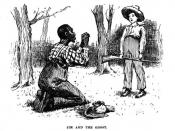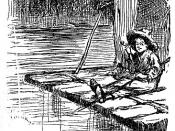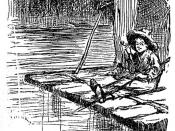Mark Twain's use of picturesque diction, symbolic punctuation, composed sentence formation, and fluent organization in this particular passage are overflowing. He uses these literary techniques to help him create the movement of the raft and time as Huck is describing it. Twain's description makes the journey seem like a peaceful experience.
The colorful diction in this passage portrays the continuous, elegant motion of the raft while Huck and Jim travel down the river. "Two or three days and nights went by; I reckon I might say they swum by; they slid along so quiet and smooth and lovely." The metaphoric diction in this sentence combines the movement of the river with the element of time to create the feeling of a peaceful, undisturbed journey. Since Huck and Jim only travel at night for their protection, the river becomes all the more serene with no commotion from the activity of the people.
Huck enjoys this tranquility. Twain's artistic diction clearly establishes this, as such in the following sentence from the passage. "Not a sound, anywheres-perfectly still-just like the whole world was asleep..." The words "not a sound," "perfectly still," and "asleep" make the journey seem very private, with Huck and Jim having minimal interaction with others, allowing the days and nights to simply blend together. Twain's vivid diction in this passage allows the reader to understand the simultaneous movement of the raft and the passing time while interconnecting the two, comparing the passing time to the steady movement of the raft.
The punctuation throughout this passage is clever. In areas where Huck is describing the imagery of the river, there are long sentences, with separate phrases combined by semicolons. This technique symbolizes the movement of the raft on the river. The constant flow of the river can be seen in Twain's...


